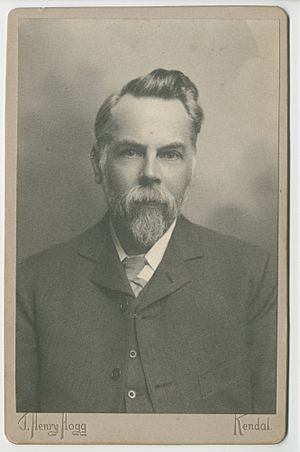Frank Kidson facts for kids
Quick facts for kids
Frank Kidson
|
|
|---|---|

Frank Kidson
|
|
| Born | 15 November 1855 Leeds, England
|
| Died | 7 November 1926 (aged 70) |
| Occupation | Folk Song Collector, Antiquarian, Author |
| Known for | Folk music collecting |
Frank Kidson (born November 15, 1855 – died November 7, 1926) was an English expert who collected and studied folk music. He is remembered for helping to save many old English songs and tunes.
Contents
Who Was Frank Kidson?
Frank Kidson was born in Leeds, England. He lived there for most of his life. At first, he worked with his brother in a shop that sold old items. Later, he became a landscape painter. This job allowed him to travel a lot. As he traveled, he met many people and learned about their local music.
A Passion for Folk Music
Frank Kidson loved both old and new folk music. He collected songs that people were still singing. His niece, Emma Mary Kidson (who he called Ethel), often helped him. He also collected old printed music. He became a top expert on these old songs.
His early books helped many people get interested in folk music. These books included Old English Country Dances (1890) and Traditional Tunes: A collection of ballad airs (1891).
Founding the Folk-Song Society
In 1898, Frank Kidson helped start the Folk-Song Society. This group worked to find and save folk songs. He used his knowledge of old songs to guide their publications. In 1915, he published English folk-song and dance with Mary Neal.
Frank Kidson did not agree with everyone about folk music. For example, he didn't like how Cecil Sharp wanted to teach folk music and dance in schools.
Later Works and Legacy
Frank Kidson published another book of folk music called A Garland of English Folk-Songs in 1926. He passed away on November 7, 1926. After his death, his niece Ethel Kidson edited two more books from his collections. These were Folk Songs of the North Countrie (1927) and English Peasant Songs (1929). They worked with Alfred Edward Moffat on these books.
Frank Kidson also studied other parts of music history. He wrote books like British Music Publishers, Printers and Engravers (1900). He also wrote The Beggar’s Opera: Its Predecessors and Successors (1922). He wrote many articles for the famous Grove Dictionary of Music and Musicians.
After he died, a large part of his personal collection was bought by the Mitchell Library. This collection included many old song sheets.

